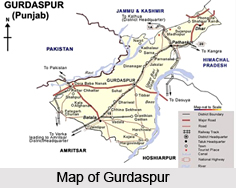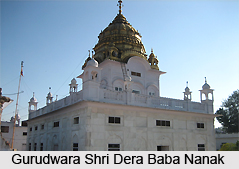 Gurdaspur is a city nestled in the Punjab state of India. The Gurdaspur district is the northern most district of Punjab state. It falls in the Jalandhar division and is sandwiched between river Ravi and Beas. The district lies between north-latitude 310-36` and 320-34` and east longitude 740-56` and 750-24` and shares common boundaries with Kathua district of Jammu and Kashmir state in the north, Chamba and Kangra districts of Himachal Pradesh in the north-east, Hoshiarpur district in the south-east, Kapurthala district in the south, Amritsar district in the south west and Pakistan in the north west.
Gurdaspur is a city nestled in the Punjab state of India. The Gurdaspur district is the northern most district of Punjab state. It falls in the Jalandhar division and is sandwiched between river Ravi and Beas. The district lies between north-latitude 310-36` and 320-34` and east longitude 740-56` and 750-24` and shares common boundaries with Kathua district of Jammu and Kashmir state in the north, Chamba and Kangra districts of Himachal Pradesh in the north-east, Hoshiarpur district in the south-east, Kapurthala district in the south, Amritsar district in the south west and Pakistan in the north west.
History of Gurdaspur
It was founded by Mahant Guriya Das Ji in the beginning of 17th century. So the city was named after him as Gurdaspur. He bought land for Gurdaspur from Jats of Sangi Gotra. It is also established that some people used to live in huts in the old city. Guriya Ji was a Sanwal Brahmin of Kaushal Gotra. He lived in Paniar village situated 5 miles north of Gurdaspur. The ancestors of Guriya Ji came from Ayodhaya long time ago and settled in Paniar. Guriya Ji had two sons Sh. Nawal Rai and Sh. Pala Ji. The descendants of Nawal Rai settled in Gurdaspur. Nawal Rai"s son Baba Deep Chand was a contemporary of Guru Gobind Singh Ji. It is believed that Guru Gobind Singh Ji gave the title of Ganj Bakhsh (Owner of Treasure) to Baba Deep Chand. The descendants of Baba Deep Chand are known as Mahants.
Important Spots of Gurdaspur
This ancient city has various spots of historical and religious significance.
Takht - I - Akbari - It is said to be the coronation site of Mughal emperor Akbar the great (1556 - 1605 AD). Here he was coroneted as the Emperor of Hindustan on 14th February 1556 AD. Humayun, the father of Akbar, died on 26 January 1556 in Delhi in a fatal accident while climbing down the stairs of Din-I-Pannah library also known as Sher - Mandal. At the time of coronation, Akbar was only 13 years 3 months old. The site is protected by Archaeological Survey of India.

Mahakaleshwar Temple - Since time immemorial, a big Shivratri fair is held every year in the Mahakaleshwar temple on Shivratri day when a large number of devotees gather here to celebrate the festival of Shivratri. It is the only temple of Shiva in India in which shivlingam is in horizontal position. This shivlingam is in Mahakaleshwar temple at Kalanaur.
Dera Baba Nanak - Dera Baba Nanak is situated 45 Kilometers west of Gurdaspur. This place is associated with Sri Guru Nanak Dev Ji. The two famous Gurudwaras at Dera Baba Nanak are Sri Darbar Sahib and Sri Chola Sahib.
Mukeshwar Temple - This temple is situated on the bank of river Ravi. It is about eight kilometers north east of Shahpur Kandi. This temple is the earliest relics of antiquity. These are said to date back to the times of the Pandavas. Stories are told of Arjun"s and Draupadi"s visit to this place.
Barath Sahib - Barath Sahib is situated 13 Kilometer west of Pathankot city. The Gurudwara of Barath Sahib is associated with Baba Sri-Chand, the elder son of Guru Nanak Dev ji. Baba Sri-Chand, the founder of Udassi sect was born on Bhadhon 9, Samvat 1551 i.e. 1494 AD in Sultanpur Lodhi.
Fairs and Festivals of Gurdaspur
The famous fairs and festivals of Gurdaspur are as follows-
Marriage of Baba Ji at Batala - Guru Nanak Dev Ji was married in Batala to Bibi Sulakhani and a big annual fair is held to commemorate the marriage. Gurudwara Dera Sahib and Kandh Sahib built on the spots where marriage rites were performed attract pilgrims from all over the state.
Baisakhi at Pandori Mahantan - Pandori Mahantan is situated 8 Kms east of Gurdaspur city. It is an old Dera (monastery) of Mahants, the management of which has passed from Guru (preceptor) to his chela (disciple) for generations. The monastery was founded sometime in the reign of Emperor Jahangir (1605-1627) by a famous of Hindu Saint Bairagi Bhagwanji.
 Baisakhi fair is observed at many places in the state. Pandori Mahantan is one such place. It is not known since when the Baisakhi fair at Pandori Mahantan is being celebrated. Some suggest that the fair was first held when Baba Narainji succeeded his Guru Baba Bhagwanji about four centuries ago and has been held every year since then. The fair lasts for three days from 1st to 3rd Baisakh, corresponding from 13th to 15th April.
Baisakhi fair is observed at many places in the state. Pandori Mahantan is one such place. It is not known since when the Baisakhi fair at Pandori Mahantan is being celebrated. Some suggest that the fair was first held when Baba Narainji succeeded his Guru Baba Bhagwanji about four centuries ago and has been held every year since then. The fair lasts for three days from 1st to 3rd Baisakh, corresponding from 13th to 15th April.
Babehali"s Chhinjh (Wrestling) Mela - Babehali is situated 4 Kms from Gurdaspur city. A Chhinjh Mela is held here every year in the last week of August. Wrestlers from India and abroad participate in this Mela. Cultural programmes are also held here by various artists from all over Punjab.
Shivratri Fair - Kalanaur, a historical town of Gurdaspur District, is situated towards the west of Gurdaspur at a distance of 25 Kilometres. Akbar was coroneted at a raised platform, 2 Kilometers east of Kalanaur on 14th February 1556 AD. Since time immemorial, a big Shivratri fair is held every year in the Mahakaleshwar temple on Shivratri day when a large number of devotees gather here to celebrate the festival of Shivratri.



















